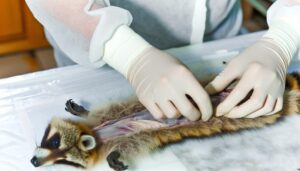How Do You Get Rid of Raccoons and Possums: 7 Effective Tips
To humanely get rid of raccoons and possums, first secure garbage and food sources by using heavy-duty cans with tight-fitting lids. Utilize natural deterrents, such as peppermint oil or predator urine scents, to create an inhospitable environment.
Install physical barriers like fencing and seal any entry points with heavy-gauge wire mesh. Employ humane trapping techniques, selecting live-capture traps and ensuring safe release at least five miles away, adhering to local regulations.
Professional wildlife removal services offer thorough inspections, trapping, sanitization, and exclusion repairs. Consistent maintenance and proactive measures can help prevent future infestations.
Explore further to gain more insight.

Key Takeaways
- Secure garbage cans with tight-fitting lids and clean them regularly to eliminate odors.
- Use plant-based repellents like peppermint oil or garlic spray to create an inhospitable environment.
- Install physical barriers such as fencing and seal entry points with heavy-gauge wire mesh.
- Employ humane live-capture traps and relocate animals at least five miles away in a suitable habitat.
- Consult professional wildlife removal services for thorough inspection, trapping, and property repair.
Identifying Raccoon and Possum Activity
Frequently, the initial step in addressing a raccoon or possum problem is accurately identifying signs of their activity around your property. These nocturnal creatures often leave telltale signs such as overturned garbage cans, scattered food scraps, and tracks.
Raccoon tracks usually show five elongated toes, resembling human hands, while possum tracks display a thumb-like toe on the hind foot. Additionally, droppings can provide clear evidence; raccoon feces are tubular and often contain seeds, while possum feces tend to be smoother and smaller.
Listen for nocturnal sounds, such as rustling or growling, which can indicate their presence. Properly identifying these signs is essential for implementing effective and humane control measures, ensuring the safety of both the animals and your property.
Securing Garbage and Food Sources
To effectively deter raccoons and possums, it is necessary to secure all potential food sources, including garbage, compost, and pet food. Unsecured waste can attract these animals, leading to potential health hazards and property damage.
Here are four essential steps to secure your waste and food sources:
- Use metal or heavy-duty plastic garbage cans with tight-fitting lids to prevent raccoons and possums from accessing the contents.
- Regularly clean garbage cans to remove lingering odors that can attract wildlife.
- Store pet food indoors and feed pets inside to avoid leaving food outside overnight.
- Compost responsibly, using enclosed bins that deter wildlife yet allow for proper composting.
Using Natural Deterrents
Employing natural deterrents can effectively discourage raccoons and possums from frequenting your property while ensuring safety and environmental sustainability.
Options such as plant-based repellents, predator urine scents, and homemade spray solutions provide non-toxic alternatives for pest control.
Utilizing these methods can help maintain a balanced ecosystem without resorting to harmful chemicals.
Plant-Based Repellents
Utilizing plant-based repellents provides a safe and environmentally friendly method for deterring raccoons and possums from your property. These natural deterrents can be strategically used to create an inhospitable environment for these creatures without causing harm.
Some effective plant-based repellents include:
- Peppermint Oil: Known for its strong scent, peppermint oil can be sprayed around potential entry points.
- Garlic: Crushed garlic or garlic oil can be used to create a barrier, as both raccoons and possums find the smell repulsive.
- Capsaicin: Derived from hot peppers, capsaicin sprays can deter these animals due to their sensitivity to spicy substances.
- Onion Extract: The pungent smell of onion extract serves as an effective deterrent when applied around your property.
Predator Urine Scents
Predator urine scents, such as those from coyotes or foxes, often serve as a powerful and natural deterrent to raccoons and possums, leveraging their instinctual fear of predators. This method utilizes the animals' acute sense of smell to create an environment that feels unsafe, thereby encouraging them to vacate the area.
It is vital to source these products from reputable suppliers to confirm authenticity and effectiveness. Application involves strategically placing the urine-soaked materials around the perimeter of the property or near entry points. While this is a humane and non-toxic option, it is important to follow safety instructions to avoid unintended exposure.
Regular reapplication may be necessary to maintain effectiveness, especially after rain or heavy dew.
Homemade Spray Solutions
Beyond predator urine scents, homemade spray solutions using natural deterrents offer another effective method to repel raccoons and possums from your property. These solutions are not only eco-friendly but also safe for pets and children.
Here are four effective recipes:
- Pepper Spray: Mix one tablespoon of cayenne pepper with one quart of water. Spray this mixture around entry points.
- Garlic Spray: Blend a few garlic cloves with water, let it sit overnight, and then spray it around the garden.
- Vinegar Spray: Mix equal parts of white vinegar and water. This can be sprayed on trash cans and compost bins.
- Essential Oil Spray: Combine eucalyptus or peppermint oil with water to create a potent deterrent.
Each solution provides a humane and sustainable approach to wildlife control.
Installing Physical Barriers
When addressing raccoon and possum infestations, installing physical barriers is a crucial step to prevent these animals from accessing your property. Begin by securing garbage cans with tight-fitting lids and using bungee cords if necessary.
Install fencing with a minimum height of four feet; guarantee it is buried at least six inches underground to prevent digging. For added security, use electric fencing along the top perimeter.
Seal all entry points to your home, such as vents, chimneys, and crawl spaces, with heavy-gauge wire mesh. Additionally, trim tree branches that provide easy access to roofs.
Regular maintenance of these barriers guarantees long-term protection, safeguarding your property and enhancing the well-being of the community you serve.
Humane Trapping Techniques
When employing humane trapping techniques to manage raccoons and possums, it is vital to select traps that are both effective and safe for the animals. Guaranteeing the well-being of the captured wildlife requires adherence to best practices in choosing the appropriate trap design and materials.
Additionally, proper methods for safely releasing the animals back into their natural habitat are essential to prevent harm and comply with local wildlife regulations.
Choosing Effective Traps
Selecting appropriate traps is crucial for humanely and effectively managing raccoon and possum populations. The right choice of trap guarantees both safety and efficacy, aligning with humane wildlife control principles.
When choosing a trap, consider the following factors:
- Type of Trap: Live-capture traps, such as cage traps, are recommended. These allow for the safe containment of the animal until it can be released.
- Size: Guarantee the trap is appropriately sized for the target animal. An undersized trap can cause stress or injury.
- Material: Opt for durable materials like galvanized steel, which can withstand weather conditions and animal attempts to escape.
- Mechanism: Traps with sensitive triggers and secure locking mechanisms reduce the risk of harm to the animal during capture.
These considerations are critical for responsible wildlife management.
Safe Release Methods
Implementing safe release methods is vital for guaranteeing the humane treatment of raccoons and possums during wildlife management efforts.
Humane trapping techniques begin with selecting appropriately sized, live-capture traps to minimize stress and injury. Once captured, it is critical to handle the animals gently, wearing protective gloves to avoid bites or scratches.
Transport the trapped animals in a secure, ventilated vehicle, making sure they are not exposed to extreme temperatures.
Release should occur at least five miles away from the capture site, in a suitable habitat that provides ample food, water, and shelter. Always verify local regulations, as some areas may have specific guidelines for wildlife relocation.
Prioritizing these methods ensures ethical and efficient wildlife management.
Professional Wildlife Removal
Professional wildlife removal services offer a safe and exhaustive solution for addressing raccoons and possums on your property. Using expert knowledge and specialized equipment, these professionals ensure the compassionate and lawful removal of unwanted wildlife.
Here are four vital steps they take:
- Evaluation: Conduct a thorough inspection of the property to identify entry points, nesting areas, and the extent of infestation.
- Trapping and Elimination: Implement humane trapping techniques to capture the animals safely without causing harm.
- Sanitization: Clean and disinfect affected areas to remove any biohazards left by the animals.
- Repair: Seal entry points and fix damages to prevent re-entry.
This all-encompassing approach prioritizes the safety of both the residents and the animals involved.
Preventing Future Infestations
Securing future infestations of raccoons and possums necessitates a strategic approach focused on sealing potential entry points and upkeeping a clean, uninviting habitat for wildlife. Make certain that all vents, chimneys, and roof openings are properly sealed with sturdy materials.
Regularly examine and mend any damaged sections of your property, as even small openings can be exploited by these animals. Keep outdoor areas clear of food sources by securing garbage bins with snug-fitting lids and refraining from using bird feeders, which can attract unwelcome attention.
Additionally, prune tree branches that offer easy access to your roof. By implementing these preventative measures, you establish an environment that is less appealing to raccoons and possums, thus safeguarding your property and ensuring safety for all.
Safe and Ethical Relocation
Ensuring the safe and ethical relocation of raccoons and possums involves following humane practices that prioritize both the well-being of the animals and the safety of human residents. Proper relocation techniques require adherence to local wildlife regulations and careful planning.
Here are key steps to take into account:
- Assessment: Conduct a thorough assessment to determine the presence and behavior of the animals.
- Humane Traps: Utilize live traps specifically designed for raccoons and possums to minimize stress and injury.
- Suitable Habitat: Choose a relocation site that provides adequate food, water, and shelter away from human habitation.
- Release Protocol: Follow a structured release protocol, ensuring the animals are released during appropriate times of day to enhance their survival chances.
Conclusion
Effectively managing raccoon and possum infestations requires a multifaceted approach, encompassing identification, securing food sources, and employing both natural and physical deterrents.
Humane trapping and professional removal services provide safe methods for addressing immediate concerns. Preventative measures, such as securing potential entry points, guarantee long-term solutions.
Ultimately, an ounce of prevention is worth a pound of cure, emphasizing the importance of proactive strategies in maintaining a wildlife-free environment, while adhering to ethical and safety standards.






